Growing a columnar apple tree
The columnar apple tree is a type of fruit crop, in which, according to the description, the number of lateral branches is insignificant. It appeared during selection based on natural mutation. It has been actively cultivated since the 70s. last century. It looks like a pyramidal poplar: small branches with flower buds grow on a thickened trunk.
- Landing technology
- Seedling selection rules
- Site selection and pit preparation
- Autumn planting
- Spring planting
- Care
- In the spring
- In summer
- In autumn
- Watering
- Top dressing
- Preparing for winter
- Pruning
- Reproduction
- Treatment against diseases and pests
- Harvesting terms and rules
- Reasons for the lack of fruiting
- Nuances when growing
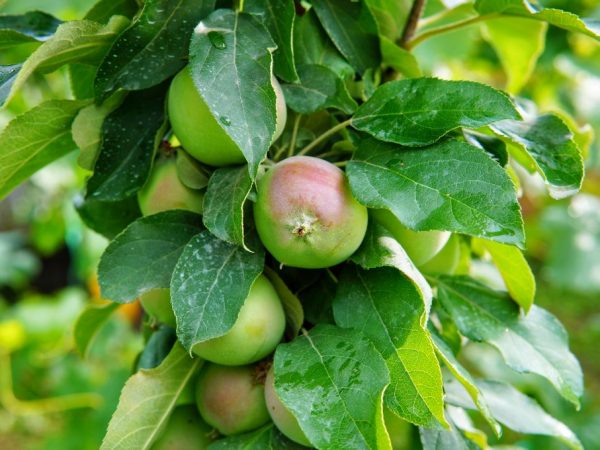
Growing a columnar apple tree
Landing technology
As a general rule, it is recommended to plan the planting of this type of apple trees in the spring, choosing early ripening varieties in order to get the first harvest next season. But this does not exclude the possibility of planting trees in the fall and choosing a seedling with increased frost resistance for planting.
Seedling selection rules
One-year-old seedlings of columnar apple trees are planted in gardens more often, but sometimes two-year old ones are also planted. Younger trees have an advantage: they adapt more quickly and easily to a new transplantation site and begin to bear fruit earlier.
A seedling for planting is chosen according to the state of the root system: there should be no rot on the roots and they should not be overdried.
It is best to purchase a seedling in a container or bucket. When buying a tree for the spring, it is kept at home on the balcony. To prevent the seedling from freezing, it should be wrapped in a dense cloth or covered with a suitable material.
You can grow a small columnar tree with a high yield in the garden. In addition, a small plot in the country is suitable for this. It fits well into the interior and does not take up much space.
Also, when choosing seedlings, pay attention to the rootstocks. Their bark color should be light green with a yellow tint or violet-red. Other rootstocks will not produce a quality horticultural crop.
Site selection and pit preparation
Gardens with open areas, well-lit by the sun, protected from strong gusts of wind are chosen for planting. These types of trees grow well on fertile soils with high permeability and friability. The permissible depth of groundwater is from 200 m.
Planting holes are made at a distance of 0.5 m from each other with a width between rows of 1 m.Optimal planting schemes: 0.5 × 0.5 × 0.5 m, 07 × 0.7 × 0.5 m, 0 , 9 × 0.9 × 0.9 m. Prepare the pit about a month before the estimated date of planting.
Preliminary preparation of the planting pit allows you to avoid the subsequent sedimentation of the soil, due to which the roots of the seedling are exposed, which leads to its death.
Soil preparation technology:
- the upper soil layer with a high content of nutrients is removed and laid out separately from the lower one, without stirring;
- drainage from a mixture of rubble and sand is placed on the bottom (in heavy soil);
- humus (compost) - 30-40 liters, superphosphate (100 g), potassium fertilizer (50-100 g) are laid in a pit with fertile soil, all components are mixed;
- dolomite flour (100-200 g) is additionally added to the acidified soil;
- after the soil has settled (after 2 weeks), the left layer of earth is poured into the pit.
Autumn planting
The permissible time for planting an apple tree in autumn is the last days of September or early October. This period shifts depending on the growing region. The general rule is that it is necessary to plant an apple tree while the weather is warm outside, the temperature remains above zero and there is no threat of frost for the next 2-3 weeks. Wherein:
- the seedling is placed in the planting hole so that the roots rise slightly on the soil surface;
- the roots are straightened so that they do not intertwine;
- after planting, at a distance of 0.3 m, a soil roller is made 10-15 cm high;
- a planted tree is watered with 10-20 liters of water;
- after complete absorption of water, the soil near the trunk is sprinkled with mulch - sawdust, peat or grass;
- if necessary, install a support so that the apple tree does not break.
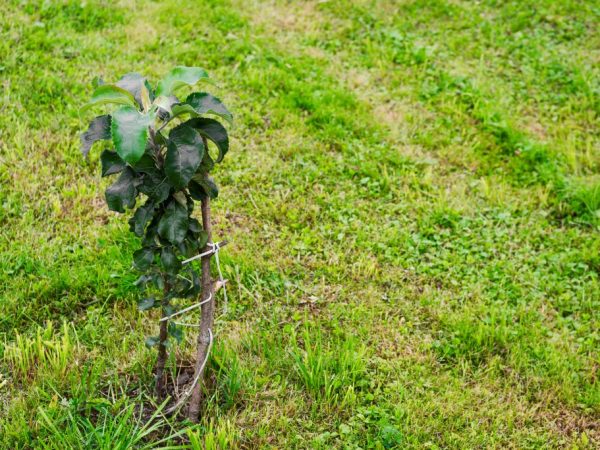
In autumn, it is better to choose frost-resistant varieties for planting.
It is better to choose frost-resistant varieties of columnar apple trees for autumn planting.
Spring planting
If the planting of trees is planned for the spring, the planting hole is prepared in the fall, so that the soil layer settles and compresses, and the fertilizers applied are completely dissolved. A young tree should be planted before the buds open.
The technology of planting apple trees in spring is similar to the rules in autumn. If planting trees in the spring is planned in regions with short and cool summers (Ural (Ufa), Siberia)), columnar crops with early ripening periods would be ideal for this.
Care
Caring for a columnar apple tree in spring, summer and autumn is slightly different, but the basic procedures remain the same: watering, feeding, treatments against diseases and pests, pruning.
In the spring
In spring, care begins with pruning and preventive treatment of trees from diseases and pests. All these procedures are done before the kidneys open. At the same time, fertilizing (mineral complexes) is introduced, which contain nitrogen.
The upper soil layer is periodically loosened to ensure the supply of oxygen to the roots located at depth. The near-trunk circle is made by tinning: they retreat from the trunk ¼ m, green manures are sown around the perimeter, which are mowed as they grow.
With spring care, the number of ovaries is normalized:
- in annual apple trees, all new buds are cut off;
- in two-year-olds, up to 10 buds are preserved;
- starting from the third year of the tree's life, the load is increased, leaving the number of buds 2 times the number of expected fruits. As a result, 2 flowers remain on one fruiting link.
In summer
It is necessary to take care of the apple tree in the summer by making top dressing and rationing the ovary. The apple tree should be fed until the second half of June, using complex mineral compositions. Feeding with organic matter and ready-made fertilizers with nitrogen is stopped at the beginning of August, replacing them with potash compounds, which contribute to the growth and strengthening of new shoots.
The rationing of the number of ovaries is carried out by thinning them. On the tree, leave ½ of those saved when pruning in the spring:
- when apples the size of a cherry grow, only 2 ovaries are left in each inflorescence;
- when the fruits resemble a walnut in size, one of the two ovaries is left.
During summer care, trees should be inspected for disease and pest damage. The treatments are stopped one month before the planned date for harvesting apples.
In autumn
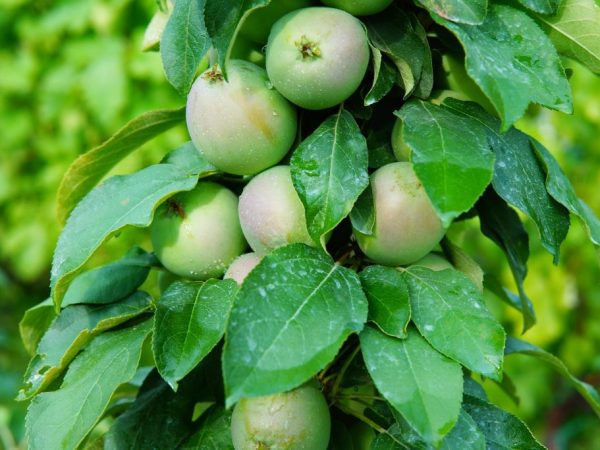
Trees need to be prepared for the winter
Caring for columnar apple trees in the fall is reduced to harvesting and subsequent preparation for wintering:
- fertilize;
- treat trees from fungi, bacteria and pests that can remain under the bark for the winter;
- make an autumn pruning of the crown.
Watering
The rules for watering columnar apple trees are based on the absence of a taproot and the superficial arrangement of branching roots that grow within a radius of up to 0.25 m from the central trunk. Such a shallow bedding of the root system requires regular irrigation, because in the hot season, the soil layer dries up, leaving the tree without moisture.
The frequency of watering depends not only on the season, but also on the age of the apple trees:
- in summer, seedlings are watered every 3 days. In hot weather - once every 2 days or daily;
- adult columnar apple trees need watering in the summer once a week. Reduce the number of procedures at the end of June and stop by August.
The recommended technology for irrigation of a columnar apple tree is drip with a dosed supply of water to the roots. Once every 4-5 days, trees are watered abundantly from a watering can so that the water penetrates to the depth of the roots.
Watering of the crown is organized every 14 days. This is done in the evening (after sunset).
Top dressing
The columnar apple tree requires a large amount of nutrition, therefore, the trees are fed throughout the growing season:
- in the spring, organic matter is preferable - fermented chicken droppings or slurry with alternating foliar spraying with urea with a concentration of 7%. A suitable time for feeding is before the beginning of the opening of the kidneys;
- until mid-summer, trees are fed by the foliar method twice with a solution of urea with a concentration of 0.1%;
- at the stage of active growth, in June, trees are fertilized with complex mineral compositions;
- during the formation of fruits, nitrogen-containing fertilizers are replaced with potash fertilizers, which also contribute to the ripening of the tops of the shoots.
Preparing for winter
For the winter, columnar apple trees are insulated by covering their stems with coniferous spruce branches or sawdust so that they do not freeze. When a sufficient amount of snow falls out, the trunk at the base is periodically earthed up, which creates additional heat.
Straw is not used to shelter trees, because it attracts rodents.
To protect the tree from future sunburn, the trunks are whitewashed with a chalk solution mixed with clay and copper sulfate. Chalk is sometimes replaced with water-based paints specially designed for whitewashing fruit crops. Additionally, the trunk is protected from rodents with a netting.
Pruning
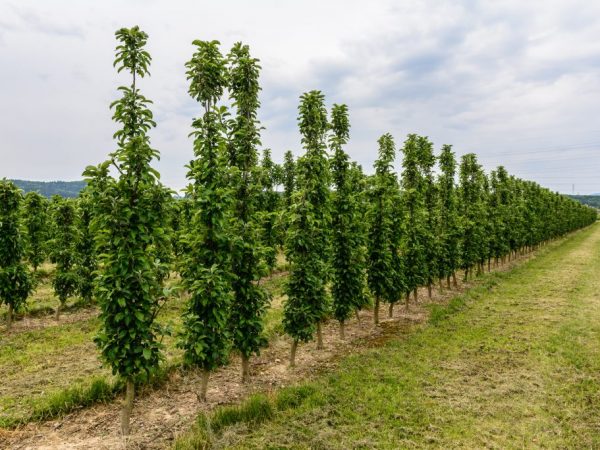
Extra branches must be cut
The peculiarity of the columnar apple compared to the usual one consists in a small number of lateral branches or their complete absence. This is an undoubted advantage, since it is not required to form a crown in such trees. It is enough to cut off unnecessary branches.
However, some gardeners prefer to form the correct pyramidal crown on the tree and prune the apple tree in the spring, summer and fall.
During summer formation, the vegetative mass of apple trees is additionally thinned out, if necessary, unnecessary shoots are trimmed.
In the spring:
- in annual trees, all lateral processes are cut off, leaving 2 buds on them, and in subsequent seasons they begin to form a pyramidal crown, removing unnecessary shoots while they are still green;
- in fruiting apple trees, branches are removed that have yielded last season.
For autumn sanitary pruning after foliage has fallen:
- remove mechanically damaged branches with signs of disease and pests;
- cut off old processes;
- shorten the tops of young branches by 2/3 so that they do not suffer from frost in winter.
In the process of forming the crown, the central conductor is not touched, because with the loss of the growth point, the columnar apple tree will begin to actively grow side branches. When a conductor with a growth point dies:
- it is pruned, keeping 2 buds;
- from the lateral branches that have subsequently grown, one is chosen, which grows vertically. She will be his replacement;
- the rest of the branches are cut into a stump.
Reproduction
The tree can be propagated by grafting the cutting onto a suitable stock.Reproduction of columnar apple trees by the seed method is practically not used, because it takes a lot of time and effort and does not always bring the desired result.
Most often, gardeners use air layers for reproduction:
- in the spring, choose the desired branch with a thickness of the diameter of a pencil;
- at its base, the bark is cut with a ring, the width of the cut is 5 mm;
- the incision made is wrapped with a cloth soaked in "Heteroauxin", leaving it for 24 hours;
- after a day, the fabric is removed, replaced with a layer of peat, covering it with black polyethylene on top;
- peat compactor is periodically moistened so that it does not dry out.
Roots will grow in the place of the incision by the fall. The branch that launched them is separated from the apple tree and planted in the ground.
Treatment against diseases and pests
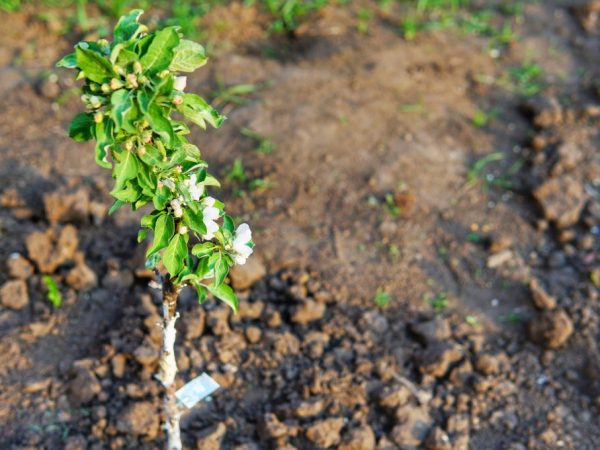
For the prevention of diseases, the tree and the ground under it are cultivated
Preventive treatment against diseases and pests is carried out in the spring (before the start of sap flow) and in the fall (after the foliage has completely fallen off). They process not only the crown, but also the trunk circle, where pathogens and insect larvae can be.
For prophylaxis, Bordeaux liquid with a concentration of 1% is used in the fall, in the spring - urea with a concentration of 7%, which not only acts as a fungicide and insecticide, but also serves as a source of nitrogen.
Harvesting terms and rules
To harvest from this species, unlike ordinary apple trees, no special devices are required, because the height of the trees allows you to do this without any improvised means.
The time for this is calculated taking into account the variety, its ripening period and the region of cultivation.
Reasons for the lack of fruiting
The columnar apple tree, in contrast to the usual, according to the description refers to crops of intensive development and is distinguished by early flowering and early maturity. It begins to bloom and bring the first harvests in the second or third year of life.
In the fifth and sixth years, the largest number of apples is obtained, noting an active increase in yield indicators, which falls after the tree reaches eight years.
The age until which such an apple tree is capable of producing a crop is 15 years on average.
The lack of flowering and fruiting can be due to a number of reasons:
- low quality seedling. In this case, it takes a long time to wait from him for the first harvest, even if all growing conditions are met;
- excessive branching. In the absence of correct pruning during crown formation, especially if the integrity of the growth point on the central conductor is violated, apple trees actively grow lateral branches and form a crown, spending all their strength on maintaining new shoots. As a result, trees do not flower or bear fruit;
- not enough food. When introducing mineral complexes, some gardeners forget about the need to feed columnar apple trees with organic matter, which should be alternated with the use of ready-made fertilizers. It is better to bring organic matter into the trunk circles in the fall;
- freezing. The reason for the lack of fruiting is often the freezing of the apical bud. This can be determined by the cessation of the growth of the central conductor and the active growth of the side branches;
- wrong choice of variety. The columnar apple variety not zoned for certain climatic conditions requires longer adaptation. Low winter hardiness is one of the reasons for the delay or complete absence of fruiting.
To correct the situation, make the tree bloom and increase productivity, foliar feeding of foliage using urea (20 g per 10 l of water) and timely removal of peduncles allow. To improve the quality of pollination, beneficial pollinating insects are attracted by planting flowers around the perimeter of the garden.
Nuances when growing
When growing columnar apple trees, you need to take into account the peculiarities of their agricultural technology:
- the disadvantage of the root system of such trees is the tendency to freeze through due to its surface location, so for the winter it is necessary to mulch the soil and cover the roots so that they do not freeze;
- the weak point of the colonovids is the apical bud of the central conductor, on which the growth and development of the seedling depend. So that the top of an immature tree does not freeze, in the first years of an apple tree's life, it is protected with a covering material (agrofibre or spandbond is suitable for this). It will also fulfill the role of protection from damage by pests and rodents;
- when growing columnar apple trees, you should not ignore the need for regular watering and feeding, because due to their superficial location, the roots are highly sensitive to lack of water and nutrition.

